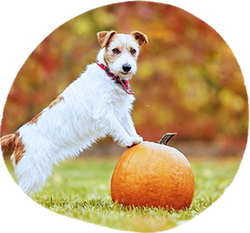No Products in the Cart
English Springer Spaniel: Characteristics, Temperament & Care Tips

Hi, Jope's squad!
Among various dog breeds, the English Springer Spaniel stands out as a beloved breed known for its friendly temperament, intelligence, and boundless energy. These dogs are not only popular as family pets but also excel in various roles, from hunting companions to show dogs. As one of the most versatile springer spaniels, the English Springer Spaniel stands out in both home and field environments.
Understanding the unique characteristics and needs of the English Springer Spaniel is crucial for potential parents to ensure they can provide the best care for these lively and affectionate dogs. Notable parents of this breed include former U.S. Presidents George W. Bush, who had a Spaniel named Spot, and George H.W. Bush, who had one named Millie. Additionally, celebrities like Princess Grace and Oprah Winfrey have also cherished their English Springer Spaniels.
This comprehensive guide will explore the history, physical traits, temperament, training needs, and health care of the English Springer Spaniel dog breed. By the end of this article, you'll have a thorough understanding of what it takes to welcome and care for an English Springer Spaniel in your home.
History of the English Springer Spaniel

The English Springer Spaniel has a rich history dating back several centuries. Originally bred in England, the English Springer Spaniel was developed for its excellent hunting abilities, particularly for flushing and retrieving game birds. While many springer spaniels have notable histories, the English Springer Spaniel is particularly distinguished by its historical roles in hunting and companionship.
The name "Springer" comes from their method of springing to the game from the cover.
In the late 19th and early 20th centuries, the breed was officially recognized and standardized. Historical records and paintings from the 16th century depict dogs resembling the English Springer Spaniel, highlighting their long-standing presence in human society. William Wallace, the commander of the Scottish army during the First War of Scottish Independence, is said to have had a pet spaniel named Merlin, who accompanied him into battle. This spaniel likely contributed to the development of the modern English Springer Spaniel.
Their lineage includes the Norfolk Spaniel, an important precursor in the breed's development.
Physical Characteristics of English Springer Spaniel
Size and Weight
English Springer Spaniels are medium-sized dogs. Males typically stand between 19 to 21 inches at the shoulder and weigh around 45 to 55 pounds. Females are a bit smaller, standing at 18 to 20 inches tall and weighing between 40 and 50 pounds. This size makes them agile and well-suited for various activities.
Coat and Color Variations
English Springer Spaniels have a distinctive double coat, featuring a medium-length outer coat that is either flat or wavy, and a dense undercoat. Common coat colors include liver and white, black and white, and tricolor (black, white, and tan, or liver, white, and tan). Seasonal shedding requires regular grooming to maintain the coat’s health and appearance.
Regular brushing helps manage shedding and keeps their coat free of mats and tangles.
Distinctive Physical Features
Among the classic breed standards, the breed is known for its expressive, almond-shaped eyes that convey a gentle and alert expression. Their long, floppy ears are another hallmark, aiding in their scenting ability but requiring regular cleaning to prevent infections. English Springer Spaniels have a well-proportioned body, with a strong back and a docked tail, which is characteristic of many hunting dogs. These physical traits contribute to their versatility both as working dogs and family pets.
Temperament and Personality of English Springer Spaniel

General Temperament
While generally quiet, English Springer Spaniels bark when necessary, making them effective watchdogs. Like other springer spaniels, English Springer Spaniels tend to be highly valued for their energetic and affectionate nature. This breed thrives on physical activity and mental stimulation, which keeps them happy and well-behaved.
English Springers are loyal and affectionate, forming strong bonds with their owners. Their keen intelligence and alertness also make them excellent working dogs, particularly in hunting and field activities. With a well-balanced temperament, they are versatile and adaptable, fitting well into various lifestyles and living environments.
Interaction with Families and Children
English Springer Spaniels are excellent family dogs, known for their gentle and patient demeanor with children. They enjoy being part of family activities and are protective yet playful. Their friendly and affectionate nature makes them a great companion for kids, often participating eagerly in games and outdoor activities.
Early socialization and training are important to ensure they develop well-rounded behavior, but their innate friendliness usually makes them beloved members of any household.
Behavior with Other Pets
Springer Spaniels generally get along well with other dogs and pets, thanks to their sociable and amiable disposition. They are not typically aggressive and can coexist peacefully with other animals if introduced properly. Early socialization is key to fostering positive interactions. Remember the difference between interspecific and intraspecific socialization, meaning socialization with other species like cats and with the same species, such as dogs.
Their friendly nature and desire for companionship extend to other pets, making them suitable for multi-pet households. However, their high energy levels mean they thrive best with pets that can match their playfulness and activity.
Notable Achievement: English Springer Spaniels have won the third most Best in Show awards at the Westminster Kennel Club Dog Show, with six titles, following Scottish Terriers with eight and Wire Fox Terriers with fourteen.


Training and Exercise Needs of English Springer Spaniel

Basic Training Tips
English Springer Spaniels are intelligent and eager to please, which makes them relatively easy to train. Begin with basic obedience training using positive reinforcement techniques such as treats, praise, and play. Consistency is key—establish a routine and stick to it.
Early socialization is crucial to help them develop good manners and adaptability. Enroll in puppy training classes to provide structure and expose them to different environments and other dogs.
Importance of Regular Exercise
As mentioned, English Springer Spaniels are energetic dogs that need regular exercise to maintain their physical and mental well-being. Aim for at least an hour of vigorous activity daily, which can include walks, runs, or playtime in a fenced yard.
Regular exercise helps prevent behavioral issues that can arise from boredom and pent-up energy, such as excessive barking and chewing.
Exercise also supports their overall well-being, reducing the risk of obesity and associated health issues like hip dysplasia.
Mental Stimulation Activities
Keeping an English Springer Spaniel mentally stimulated is just as important as physical exercise. Incorporate activities like puzzle toys, obedience training sessions, and agility courses to challenge their minds.
Games that utilize their natural hunting instincts, such as fetch or hide-and-seek with toys or treats, can be very engaging. Regular mental stimulation helps prevent separation anxiety and destructive behaviors, ensuring a happy and well-adjusted dog.
Health and Lifespan of English Springer Spaniel

Common Health Issues
Like many dog breeds, most English Springer Spaniels are typically healthy but can be susceptible to certain health conditions. Common to springer spaniels, this breed requires careful monitoring for signs of joint issues and ear infections. Common issues include:
- Ear infections: Their long, floppy ears can trap moisture and debris, making them prone to infections.
- Eye conditions: Such as progressive retinal atrophy (PRA) and cataracts.
- Hip dysplasia: A hereditary condition affecting the hip joint's development.
- Elbow dysplasia: Another joint-related issue that can impact mobility and quality of life.
- Bloat (Gastric dilation or gastric torsion): A life-threatening condition where the stomach fills with gas and twists.
Responsible breeding and regular health check-ups can help mitigate these issues. Like for any dog, it's always a good idea to have a pet insurance. Getting your English springer spaniel from a reputable breeder will also help to limit the odds of these genetic conditions.
Joint Health Issues
Joint health is a critical aspect of caring for an English Springer Spaniel. Hip dysplasia is a hereditary condition that affects the hip joint's development, leading to pain and mobility issues. To prevent and manage joint problems, it’s important to maintain a healthy weight and provide effective joint supplements.
Although glucosamine and chondroitin are widely used, recent studies have shown they are no more effective than a placebo for your springer spaniel joint health. Additionally, there are very few studies on MSM.
However, newer ingredients like UC-II® collagen, or EPA and DHA (the good Omega-3 fatty acids for joint health), and Curcumin from Turmeric have shown excellent results in studies.
Other promising ingredients include green-lipped mussels and CBD, which have shown potential but require further confirmation.
Preventative Care and Regular Check-Ups
Regular veterinary visits are essential for the early detection and prevention of health problems in your springer spaniels. Routine check-ups for these dogs should include hip and elbow evaluations, eye exams, and screenings for common genetic disorders. Preventative care, such as vaccinations, parasite control, and dental hygiene, also plays a crucial role in maintaining the overall health of your springer spaniel.
Average Lifespan
English Springer Spaniels typically have a lifespan of 12 to 14 years. Longevity can be influenced by genetics, diet, exercise, and regular veterinary care.
Grooming and Maintenance of English Springer Spaniel

Coat Care and Grooming Routines
Regular grooming is essential for maintaining the beautiful coat of an English Springer Spaniel. Grooming English Springer Spaniels involves frequent brushing to prevent matting and reduce shedding, given their medium-length, double coat.
It's important to note that springer spaniels shed, especially seasonally. Frequent brushing not only helps manage this shedding but also keeps their coat free of mats and tangles.
Aim to brush your Springer at least three times a week. Regular baths, about once a month, help keep their coat clean and healthy. Pay special attention to their feathered areas, as these can easily become tangled and dirty.
Nail, Teeth, and Ear Care
Maintaining your Springer's nails, teeth, and ears is crucial for their overall health. Trim their nails regularly to prevent overgrowth and discomfort. Brush their teeth several times a week to avoid dental issues. Clean their ears weekly to prevent infections, a common problem due to their floppy ears.
Seasonal Grooming Needs
Adjust grooming routines seasonally. During shedding seasons in spring and fall, increase brushing frequency to manage hair loss and keep your dog comfortable.


Nutrition and Diet of English Springer Spaniel
Recommended Diet and Nutritional Needs
English Springer Spaniels require a balanced diet that supports their active lifestyle and overall health. High-quality commercial dog food, formulated for medium-sized breeds with moderate to high energy levels, is a good choice. Look for dog food that lists meat as the first ingredient and avoids too much fillers like corn and soy. Including fresh fruits and vegetables can provide additional nutrients.
As vets, we generally recommend tailored homemade food made by a vet nutritionist, balanced fresh food approved by your vet, balanced raw food balanced by a board-certified nutritionist, or veterinary petfood brands. But always check with your vet.
Additionally, incorporating joint supplements such as UC-II® collagen, omega-3 fatty acids, and curcumin can help maintain joint health and mobility.
Regular veterinary check-ups can help tailor the diet to your dog's specific needs and monitor their overall health.
Did You Know?: In 1881, the American Spaniel Club was founded, emphasizing the long history and importance of breed-specific care and standards.
Living Conditions for English Springer Spaniel
Ideal Home Environment
English Springer Spaniels thrive in homes where they have plenty of space to run and play. They are best suited for homes with a large yard, as they need regular exercise to stay healthy and happy. This breed loves being part of family activities and enjoys interactive play.
Read more about other breeds like German Shepherds, Labradors, Chow Chows, and Great Danes.
Adaptability to Different Living Situations.
Springer Spaniels are adaptable and can live in various environments, including urban settings, as long as they receive adequate exercise and mental stimulation. They are sociable dogs that enjoy being around people and other pets, making them well-suited for both single and multi-pet households.
Tips for Apartment Living
- Ensure English Springer Spaniels get plenty of daily exercise through long walks, play sessions, and mental stimulation activities. We know this is not the easiest but this is something that has to be done.
- Training and establishing a routine can help manage their energy levels.
- Provide interactive toys to prevent boredom.
- Consistent playtime can help prevent boredom-induced behaviors
Adoption and Breeder Considerations
Adoption from Rescue Organizations
Adopting an English Springer Spaniel from a rescue organization offers many benefits. Rescues often provide dogs that are already house-trained and have undergone health evaluations. Additionally, adopting from a rescue helps give a dog a second chance at a loving home.
The American Kennel Club's Rescue Network is a valuable resource for finding breed-specific rescues.
Questions to Ask Before Adoption
Before adopting an English Springer Spaniel, consider the following questions:
- What is the dog's medical history and are there any ongoing health issues?
- How does the dog behave around other pets and children?
- What is the dog's temperament and personality like?
- Is the dog house-trained and well-socialized?
- What is the dog's exercise and grooming routine?
Did You Know?: The AKC standard for the English Springer Spaniel, formed in 1927 and revised in 1932, was made to foster the natural ability of the Springer while encouraging uniformity within the breed.
Conclusion
In conclusion, English Springer Spaniels are exceptional dogs with a rich history and a heart full of affection. Their intelligence, energy, and sociable nature make them not only versatile working dogs but also cherished family companions. While they may face certain health challenges, proactive care and a focus on joint health can ensure they lead long, active lives.
By understanding their unique needs and providing them with proper nutrition, exercise, grooming, and love, you can forge an unbreakable bond with your Springer Spaniel. Prioritizing their joint health with supplements like Jope's Hip & Joint Dog Chews is an investment in their well-being. Embrace the journey of English Springer Spaniel ownership, and cherish the joy and loyalty these magnificent dogs bring to your life.


Author: Dr. Jeremy
Doctor of Veterinary Medicine (DVM), MS









Leave a comment